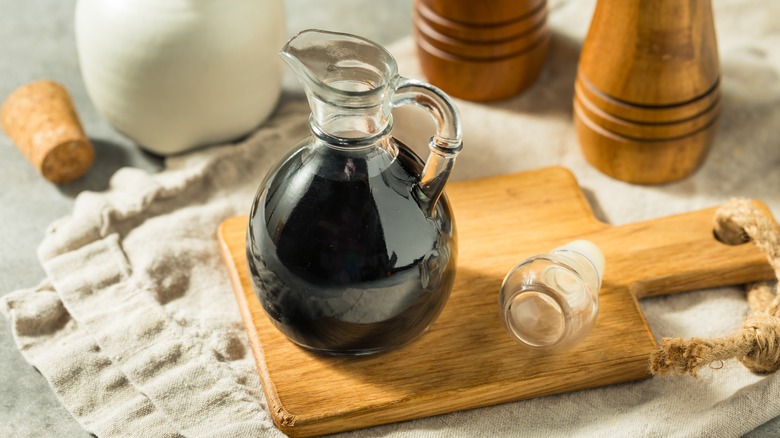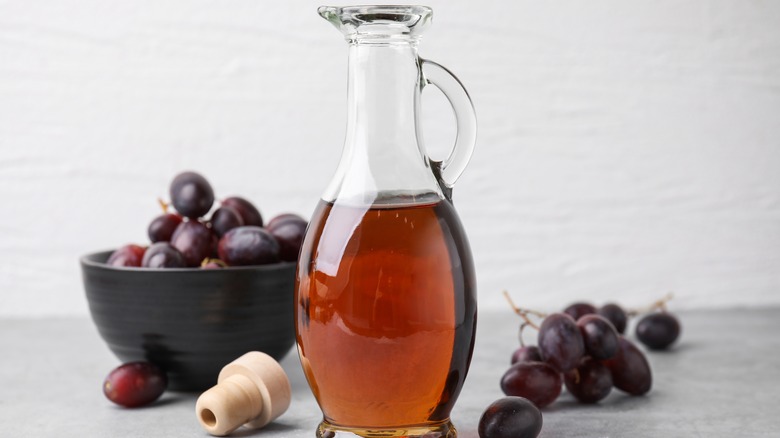Grab Some Soy Sauce For One Of The Easiest Balsamic Vinegar Substitutes
Take fermented grapes and age them in wooden casks for a decade or so, and you'll end up with the dark, sweet-yet-tart, syrupy treat that is balsamic vinegar. If you have a soft spot for Italian recipes, you'll come across this condiment eventually. It's super versatile, from salad dressings to marinades to glazes. But what do you do when you're in the middle of cooking and realize you're out of balsamic vinegar? The first thing is to check your pantry and see if you have some soy sauce lying around. If you do, you're in luck: Soy sauce works pretty well as a substitute for balsamic vinegar.
Other than having a dark color that matches fresh balsamic vinegar, soy sauce's slight acidity is why it works as a swap. Even though the first thing that'll hit your tongue when you taste it is a shot of savory umami, a hint of sourness follows soon after. It won't ever taste exactly the same, but it's still an excellent swap, and even an intriguing departure from your usual formula. Here's the thing, though: If you have a little bit more time, you can actually tailor it to taste even more like balsamic vinegar.
Use red wine vinegar as a base for your substitute
To match the flavor of balsamic vinegar more closely in your soy sauce-swapped dishes, you'll need to enlist the help of a few other ingredients. First, there's red wine vinegar, which acts as an acidic foundation. Technically, any vinegar will do for acidity, but red wine vinegar shares the same fruity, grape-based flavor, and the matched dark red color is a plus. There are key differences between balsamic and red wine vinegar, but here, they're negligible.
Since one of the key flavors of balsamic vinegar is sweetness, the next addition is a sweetener. Avoid sugar, though — you'll want something more organic tasting, like honey or maple syrup. Pick whichever you have in your kitchen and stir it into the red wine vinegar using a 3-to-1 ratio (that means a teaspoon of sweetener for every tablespoon of vinegar you use). The result is a sweet and tangy sauce that closely resembles balsamic vinegar. It might be a bit more savory due to the soy sauce, but it'll still give your dishes that characteristic balsamic zing. Try it on a balsamic chopped chicken salad sandwich and have your mind blown.
No vinegar? No worries!
If you couldn't find red wine vinegar in your kitchen, you're not out of luck just yet. See if you can scrounge up a few lemons in the fridge and get some fresh juice out of them. In the absence of vinegar, fresh lemon juice will do great as an acidity base. For sweetness, molasses is ideal, offering a caramelized depth that mimics aged balsamic. But if you don't have molasses (and let's face it, it's not exactly a pantry staple), grape jelly can work just fine. It's sweeter and fruitier, but it pairs beautifully with lemon's tartness.
To make your substitute, simply whisk together the lemon juice and your chosen sweetener. Make sure they're well combined before adding a splash of soy sauce. This final ingredient brings a savory note and extra acidity that rounds out the flavors, making your mixture more complex — just like real balsamic vinegar.
Once the sauce is smooth, taste it. Once again, it isn't going to be a one-to-one replacement for balsamic vinegar. But drizzle this over your Italian pasta salad, and you'll be surprised by how well it works.


